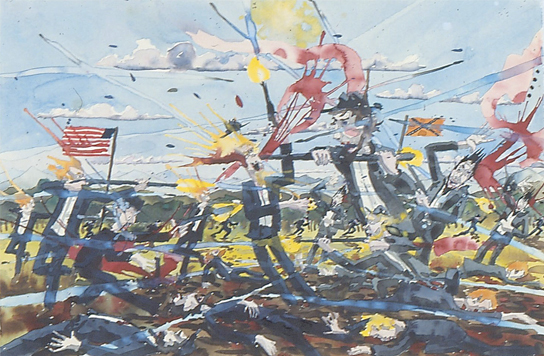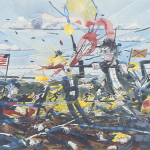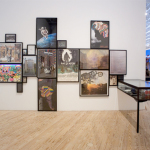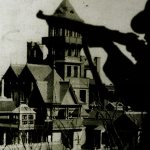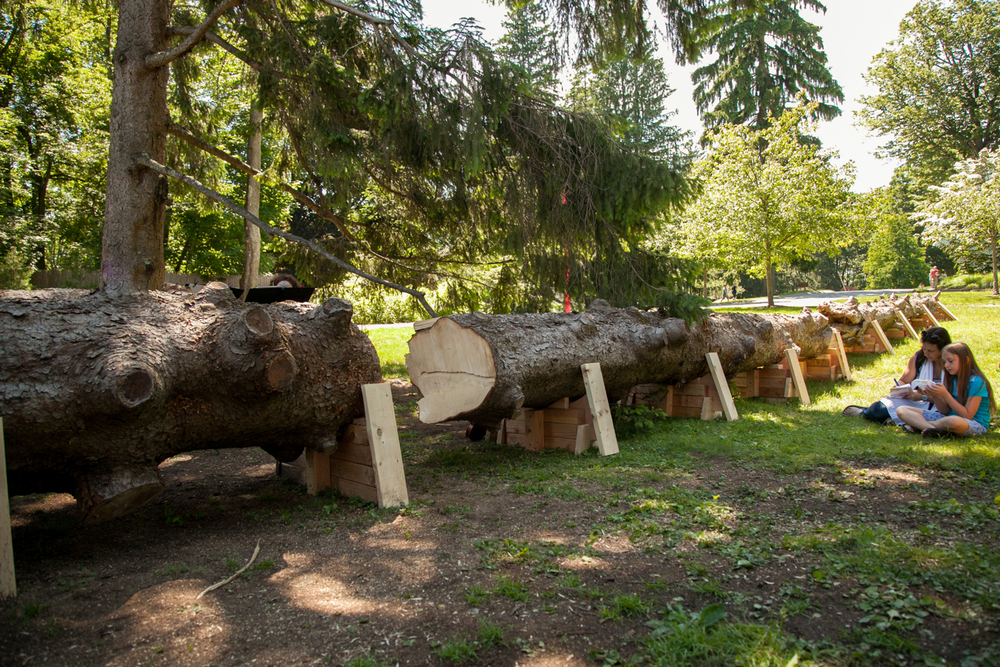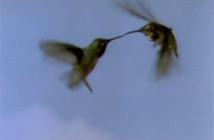A large, sparsely detailed diorama by Sam Durant depicts the English-speaking American Indian, Squanto, teaching a grateful pilgrim how to fertilize a cornfield with fish. One nearly dismisses this display of aesthetic plainness and iconic familiarity, but when the scene rotates ever so slowly it reveals a not-so-familiar story: an outraged Miles Standish has just upturned a table and is about to beat a member of the Pequot tribe to death. According to text accompanying the piece, Standish will later lead a charge to wipe out the Pequot people. The feast celebrating the settlers' violent success in defeating the tribe is believed to be the basis for our Thanksgiving. Both scenes were displayed in a wax museum in Plymouth, but due to public protest the one depicting the beating was removed in 1970s. The artwork, Pilgrims and Indians, Planting and Reaping, Learning and Teaching, is so seemingly trite and instantly chilling. It serves as a reminder that myths often outlive truth, particularly as history is written by the victors.
"The Old, Weird America: Folk Themes in Contemporary Art," at the DeCordova Sculpture Park and Museum through September 7, is a breezy, well-paced show with a selection of mostly strong contemporary art related to American mythology and inspired by folk tradition. As with Durant's piece, the myths often shield unpleasant and, at times, contradictory truths. That idea is a reoccurring and perhaps overstated theme throughout the show. The title of the show and the use of the word "folk" make for an interesting problem: Folk as a cultural practice necessarily thrives outside of galleries and museums; its economics and tropes are far from the concerns of academia and the market.
The standout work in the exhibition is a video that embodies all of the show's themes in a pleasantly obtuse manner. Jeremy Blake's haunting Winchester depicts still, colorless panoramas of the Winchester heiress mansion with its doors and stairwells leading to nowhere. The picture fades in and out and flickers while ghostlike forms insert themselves into the frame. Blake's signature colorful abstractions fill the screen all the while a contrived projector sound whirs creating the illusion of witnessing a projected piece of film. American myth and madness go hand in hand and the targets of one generation are the next ones' ghosts. That the artist Blake suffered his own delusions that led to suicide adds an unintended element of pathos to the video.
In 8 Possible Beginnings or: The Creation of African-America, a Moving Picture, Kara Walker makes myths of myths, using among other sources the Uncle Remus tales. With shadow puppetry Walker emulates her own silhouette drawings and taps into a rich storytelling tradition (one that is more Chinese and Indonesian than American). In one segment, her protagonist slave girl witnesses Br'er Rabbit and Br'er Fox lynch three slaves to dialogue from the Disney's "Song of the South". The slave girl is the only puppet to be held by a human hand that reveals at times, a woman (presumably Walker) animating her and providing her voice. Children accept myths as truth and the Uncle Remus tales, at least the Disney version, reduce the Southern African-American experience to shameful caricature, and accepting this caricature both negates narratives of horror and infantilizes the "other." Walker re-introduces the murderous and the sexual to fairy tales, drawing them toward a semblance of truth.
Dario Robleto takes objects imbued with their own talismanic history -- bone, cassette tapes, old 45's, paper flowers crafted by war widows, bullet casings -- and transforms them into new relics. His grinding, weaving and re-fashioning becomes a kind of alchemy with its inherent aura of destruction and creation. Unfortunately, in other surveys his work contained a potent element of shock, and here the lighting and cramped placement somehow make his craftsmanship seem cheap, lessening the wonder of his work.
Brad Kahlhamer's large drawing Waqui Totem USA depicts a cartoony, calligraphically-inked, nightmarish totem pole that weaves around washes of spectral bison, piled skulls, and Indian heads whose eyes glare at the viewer. Hair strands and ghostly eagles also weave through small scenes from "The Searchers," a movie in which John Wayne plays an ex-Confederate soldier who harbors a deep hatred of Indians goes on a years-long search for his niece, only to discover she lives as one of them. Kahlhamer (who is of Native American ancestry and was adopted by a White couple) seems to suggest with this sprawling work that history is a dense amalgamation of horrors -- fluid and phantasmagoric as captured by his obsessively scrawled ink and wash.
Matthew Day Jackson's Garden of Earthly Delights (Spiritual America) casts a wide thematic net. He cut up movie and music posters and photographs and combined them with other materials, hung them upside down or simply left them alone. The shape the posters create together could be a loose United States map with a long display case resembling Florida that houses a race car "blower scoop" and fake taxidermy among other objects. What makes these images significant to Jackson is somewhat clear -- the artist's fascination with natural forms that embody an anthropomorphic quality as in the race car parts he included -- but the works’ treatment isn't particularly interesting and the references seem too consciously hip.
Barnaby Furnas contorts flattened forms of soldiers, dropping them in brightly lit fields of battle where blood doesn't so much splatter as ejaculate. These grisly vectors are lines of death that intersect bodies with a savage geometry, the only sense of order in the chaos of war. Eric Beltz's meticulously rendered drawings of colonial figures, beautiful as they are, are just plain odd and possibly a bit too technically clean. Thomas Jefferson stands, one foot posed on a pile of recently-cut firewood and the phrase "Good Luck, Assholes" surrounds him. In another drawing Fuck You, Tree Washington sits hunched over on a tree stump, contemplative --not quite the regal stance befitting the "Father of Our Country." Some of the floating phrases, which are written in Old English lettering, and surround these mythic (and neck-less) figures, form pentagrams. For all the importance and sacredness surrounding the ideals of our so-called forefathers and for their new country, it is as though these men knew that they could always count on future generations to screw shit up.
These and other works in the exhibition are inspired by folk as an expression of oppressed minorities, as an element of social change and protest and as a long traditionally craft-oriented object-making continuum. However, an important aspect of folk is that it is the practice of those geographically and culturally "outside" and the discomforting absence of outsider art is disconcerting. Harry Smith's Folkways album cover is present, but why not his magical animations? The curators could also have been taken liberty with the notion of outsiderism -- or at least weirdness -- to include, say, avant-garde filmmakers such as Kenneth Anger (how much more 'weird America' can you get?) or other unsung heroes of America's own folk-like tradition of underground art. This survey’s themes of myth-busting and alternate histories make it quite engaging and at times surprising, but with only a trace of the weird America outside the museum doors.
- Barnaby Furnas, Untitled Battlescene, October 17, 2001, Watercolor on paper, 2001
- Matthew Day Jackson, Garden of Earthly Delights (Spiritual America) 2008 Posters, needlepoint, glass and steel vitrine, wool, paint, C-print, fake taxidermy, wood, blower scoop, 2008
- Jeremy Blake, Video still from Winchester, DVD: color, sound, 18 minutes (continuous loop), 2002.
DeCordova Museum and Sculpture Park
"The Old, Weird America: Folk Themes in Contemporary Art" is on view June 6 - September 7, 2009 at the DeCordova Museum and Sculpture Park.
All images are courtesy of the DeCordova.

